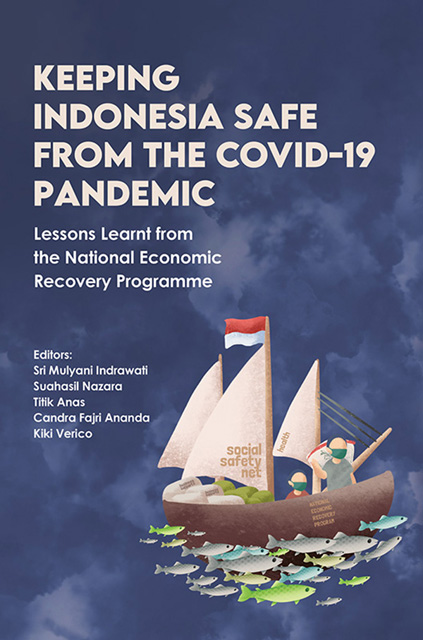 Keeping Indonesia Safe from the COVID-19 Pandemic
Keeping Indonesia Safe from the COVID-19 Pandemic Book contents
- Frontmatter
- Contents
- List of Figures
- List of Tables
- List of Boxes, Annexes and Appendixes
- Acknowledgements
- Glossary
- The Contributors
- Foreword: Keeping Indonesia Safe from the COVID-19 Pandemic Lessons Learnt from the National Economic Recovery Programme
- Part I Health Shock
- Part II Economic Shock: The Framework
- Part III Revenue Shock And Response
- Part IV Expenditure Side (Human Capital)
- Part V Expenditure Side (Msmes And Corporate Sector)
- Part VI Regional Dynamics
- Part VII New Ways Of Working
- Index
16 - Regional Dynamics during the COVID-19 Pandemic in Indonesia
Published online by Cambridge University Press: 30 June 2023
- Frontmatter
- Contents
- List of Figures
- List of Tables
- List of Boxes, Annexes and Appendixes
- Acknowledgements
- Glossary
- The Contributors
- Foreword: Keeping Indonesia Safe from the COVID-19 Pandemic Lessons Learnt from the National Economic Recovery Programme
- Part I Health Shock
- Part II Economic Shock: The Framework
- Part III Revenue Shock And Response
- Part IV Expenditure Side (Human Capital)
- Part V Expenditure Side (Msmes And Corporate Sector)
- Part VI Regional Dynamics
- Part VII New Ways Of Working
- Index
Summary
INTRODUCTION
The impact of COVID-19 on the economy is more severe than the 2008 global economic crisis that was felt by many countries in the world because the global economic crisis was mainly related to the global financial crisis and mostly felt by developed countries, while the economic crisis due to the COVID-19 pandemic is a health crisis that crippled the economy and felt by all countries, and not a single country was free from the COVID-19 pandemic. The crisis caused by the pandemic is also the first experience in the modern era and it needs extraordinary policies that had never been implemented before. The rapid spread of the COVID-19 virus globally in 2020 negatively impacted the world's economy, including Indonesia. Implementation of government policies to restrict mobility and direct interaction among the population has a significant impact on the decline of economic and social activities. In 2020, the world economy contracted by 3.1 per cent, in which the economies of developed countries recorded a larger contraction of 4.5 per cent than the emerging market and developing economies which experienced a decline of 2.1 per cent (IMF 2021). Meanwhile, the Indonesian economy also contracted by 2.1 per cent lower than the rate at which the global economy declines (BPS 2021). When looking at economic growth on quarterly bases, economic growth in the first quarter of 2020 was only 3.0 per cent, lower than an average yearon- year (YoY) growth of 5.0 per cent. This was followed by consecutive contractions of –5.3 per cent in Q2 2020, –3.5 per cent in Q3 2020 and –2.2 per cent in Q4 2020. Those declines indicated that the Indonesian economy fell into recession.
The COVID-19 pandemic had a detrimental effect on Indonesia's economy, not only at the national level but also at the regional level. This was shown by slowing economic growth, increasing unemployment and poverty in almost all provinces. However, the diverse characteristics of regions in Indonesia create regional dynamics where the impact of the pandemic on the regional economy is not symmetrical. For instance, Bali, which is highly dependent on the tourism sector, was most significantly affected by the COVID-19 pandemic.
- Type
- Chapter
- Information
- Keeping Indonesia Safe from the COVID-19 PandemicLessons Learnt from the National Economic Recovery Programme, pp. 521 - 548Publisher: ISEAS–Yusof Ishak InstitutePrint publication year: 2022
